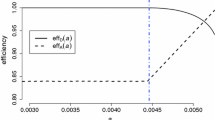Abstract
We consider the problem of estimating input parameters for a differential equation model, given experimental observations of the output. As time and cost limit both the number and quality of observations, the design is critical. A generalized notion of leverage is derived and, with this, we define directional leverage. Effective designs are argued to be those that sample in regions of high directional leverage. We present an algorithm for finding optimal designs and then establish relationships to existing design optimality criteria. Numerical examples demonstrating the performance of the algorithm are presented.
Similar content being viewed by others
References
Belsley D, Kuh E, Welsch R (2004) Regression diagnostics: identifying influential data and sources of collinearity. Wiley, New York
Emery A, Fadale T (1996) Design of experiments using uncertainty information. J Heat Transf 118: 532
Fadale T, Nenarokomov A, Emery A (1995) Two approaches to optimal sensor locations. J Heat Transf 117: 373
Hoaglin D, Welsch R (1978) The hat matrix in regression and ANOVA. Am Stat 32(1): 17–22
Hocking R (2003) Methods and applications of linear models: regression and the analysis of variance. Wiley, New York
Pukelsheim F (2006) Optimal design of experiments. Society for Industrial Mathematics
Redhe M, Forsberg J, Jansson T, Marklund P, Nilsson L (2002) Using the response surface methodology and the D-optimality criterion in crashworthiness related problems. Struct Multidisciplinary Optim 24(3): 185–194
Smith W (2005) Experimental design for formulation. Society for Industrial Mathematics
St John R, Draper N (1975) D-optimality for regression designs: a review. Technometrics 17(1): 15–23
St Laurent R, Cook R (1992) Leverage and superleverage in nonlinear regression. J Am Stat Assoc 87(420): 985–990
Tarantola A (2005) Inverse problem theory and methods for model parameter estimation. Society for Industrial Mathematics
Tenorio L (2001) Statistical regularization of inverse problems. SIAM Rev 43(2): 347–366
Uciński D (2005) Optimal measurement methods for distributed parameter system identification. CRC, Boca Raton
Wang J, Zabaras N (2004) A Bayesian inference approach to the inverse heat conduction problem. Int J Heat Mass Transf 47(17–18): 3927–3941
Wang J, Zabaras N (2005) Using Bayesian statistics in the estimation of heat source in radiation. Int J Heat Mass Transf 48(1): 15–29
Author information
Authors and Affiliations
Corresponding author
Rights and permissions
About this article
Cite this article
Burch, N., Hoeting, J.A. & Estep, D. Optimal design and directional leverage with applications in differential equation models. Metrika 75, 895–911 (2012). https://doi.org/10.1007/s00184-011-0358-4
Received:
Published:
Issue Date:
DOI: https://doi.org/10.1007/s00184-011-0358-4




